Abstract
Three hundred and twenty nine strains of non-penicillinase-producing Neisseria gonorrhoeae (non-PPNG) isolated from men and women were tested for their susceptibility to a range of antibiotics, and were also auxotyped and serogrouped. Nearly 6% (18) of 312 strains tested were resistant to 1 mg/l or more penicillin (compared with 4.4% of PPNG strains isolated in 1981). Many (198, 64%) strains showed intermediate resistance to penicillin (0.12-0.5 mg/l). Nearly 5% (15) of 312 strains tested were resistant to 0.5 mg/l or more cefuroxime, and there was a high degree of cross resistance between these two antibiotics. High levels of resistance to erythromycin and tetracycline were also found, and there was also appreciable cross resistance between these antibiotics and the beta lactam drugs. Resistance to spectinomycin was rare, and there was no cross resistance between spectinomycin and other agents tested. Levels of resistance between strains isolated from different anatomical sites did not differ, except that resistance to erythromycin was greater in rectal isolates. Four main auxotypes were detected. Strains requiring arginine, hypoxanthine, and uracil (AHU-) were more prevalent from the cervix. We have shown that there is an association between auxotype, serogroup, and level of sensitivity to penicillin, cefuroxime, and tetracycline.
Full text
PDF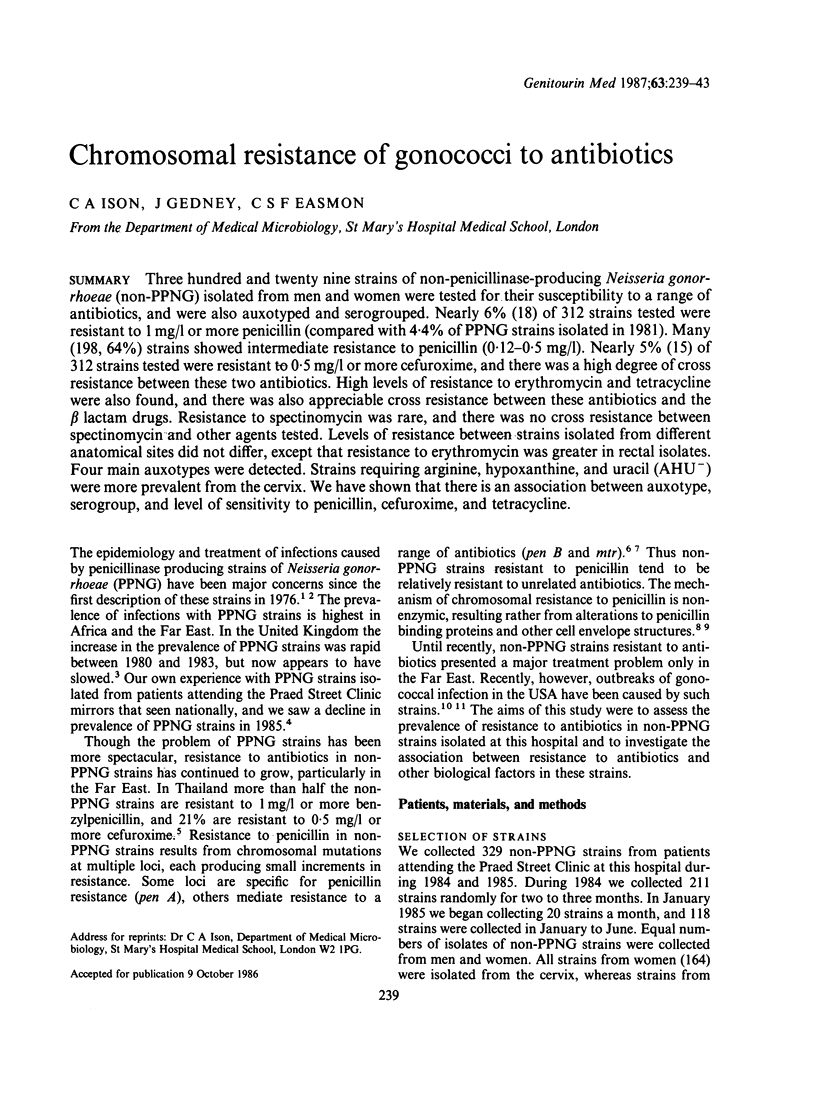
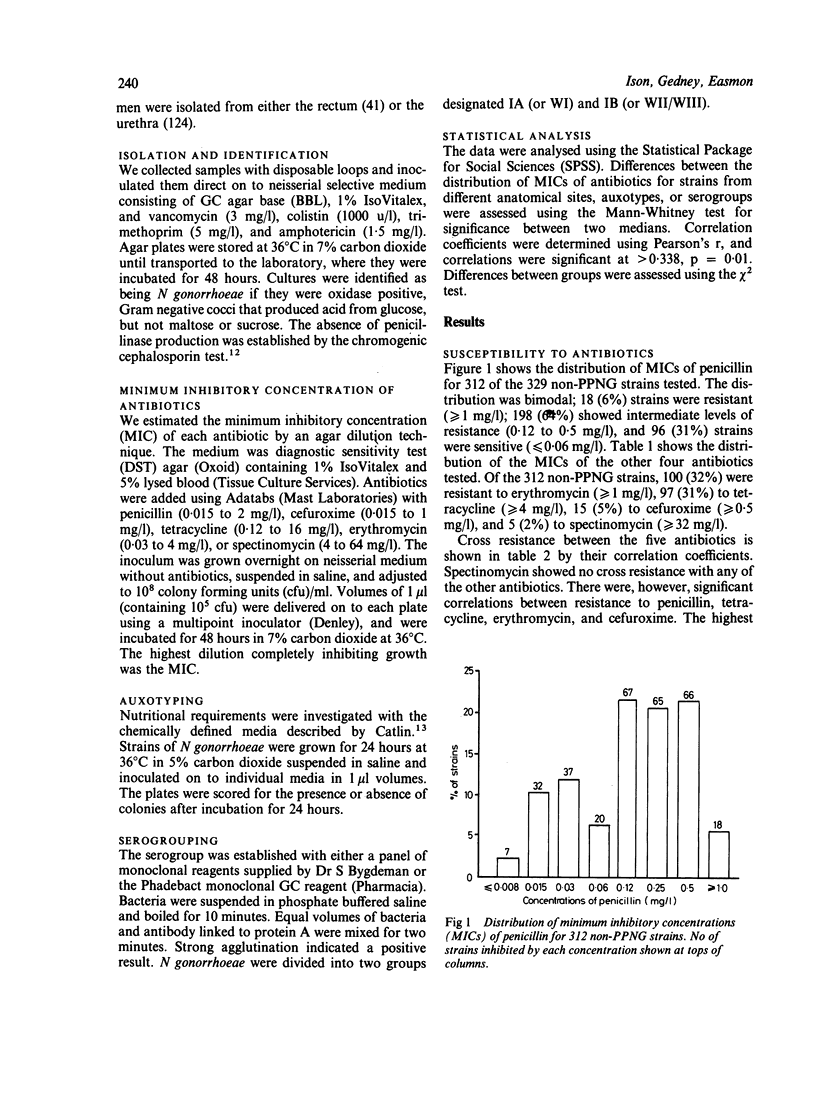
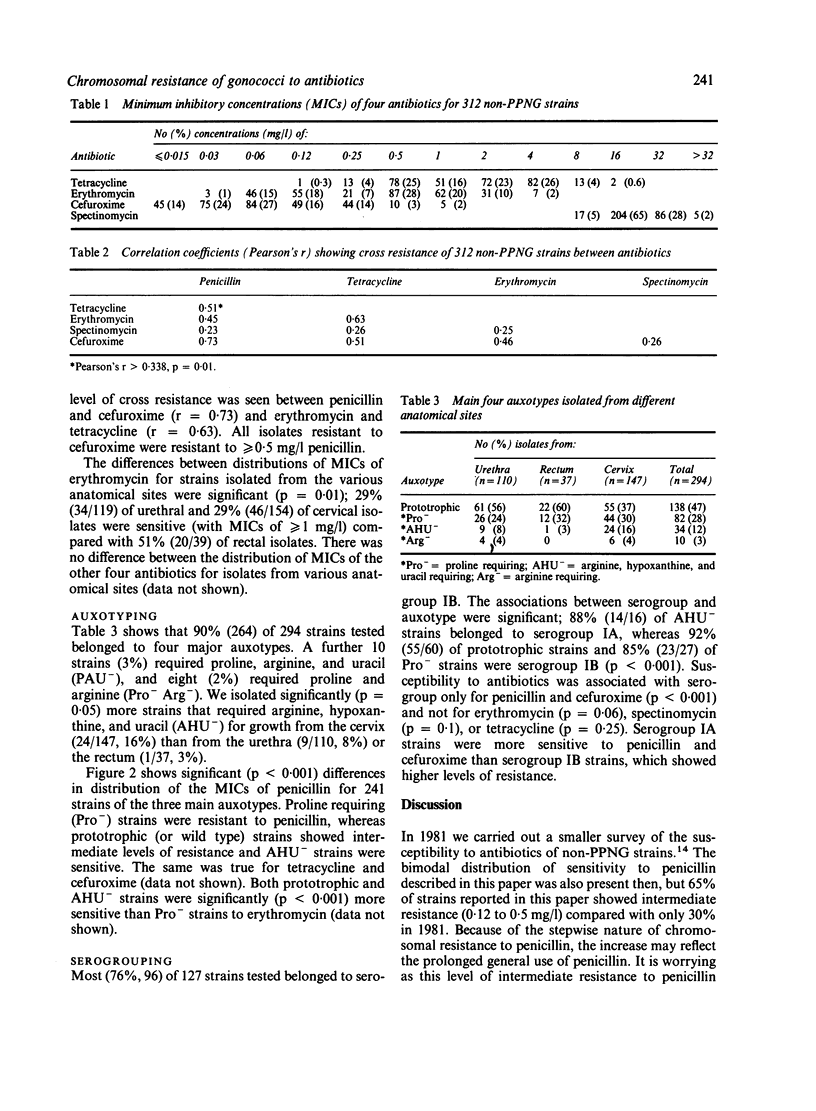
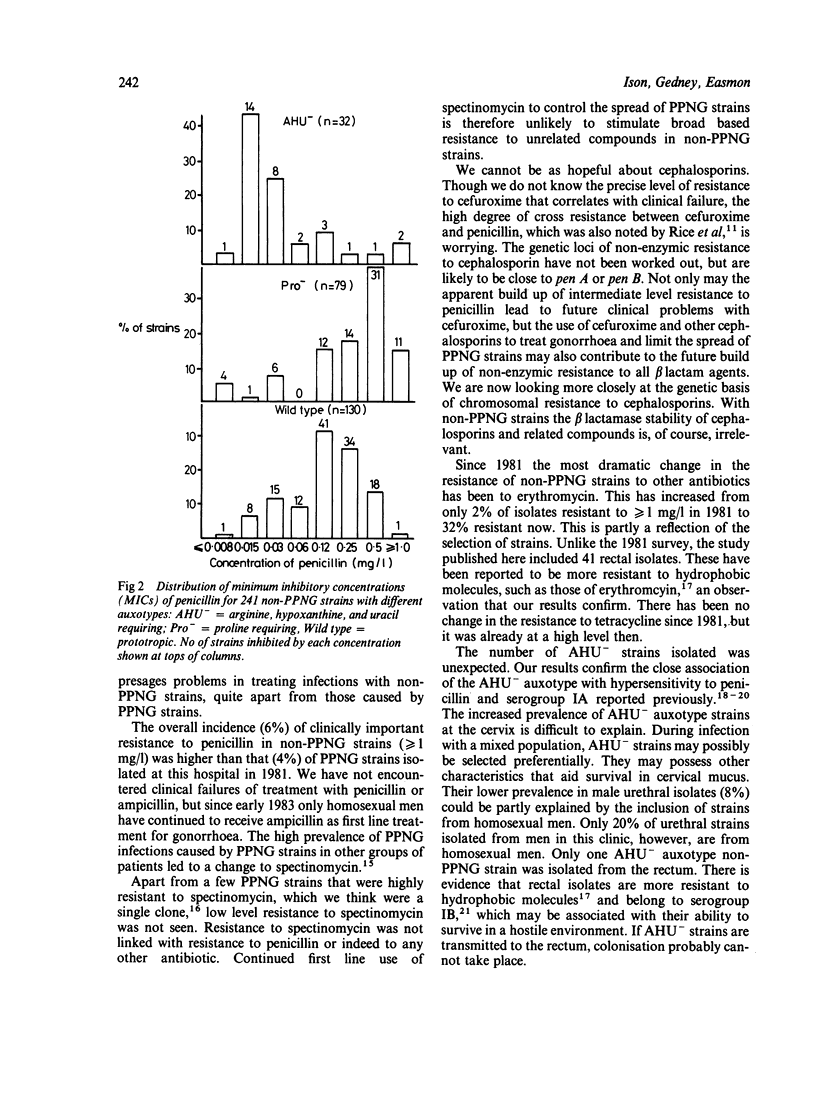
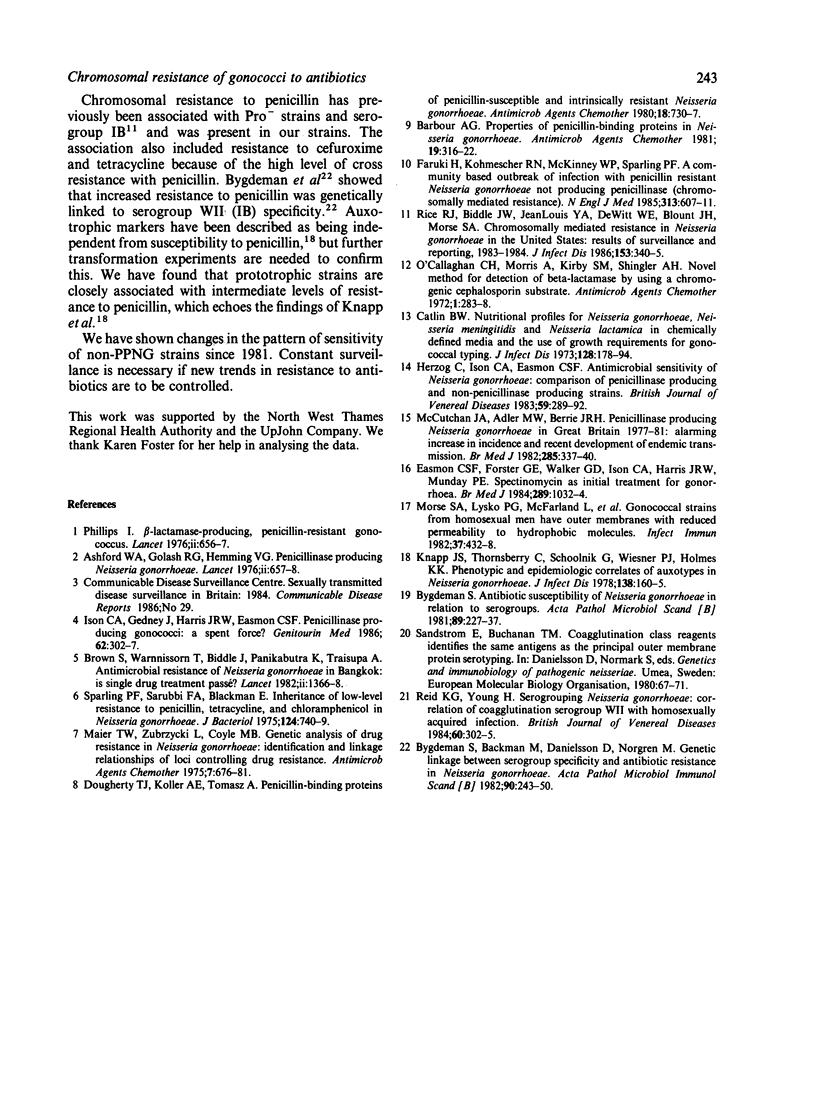
Selected References
These references are in PubMed. This may not be the complete list of references from this article.
- Ashford W. A., Golash R. G., Hemming V. G. Penicillinase-producing Neisseria gonorrhoeae. Lancet. 1976 Sep 25;2(7987):657–658. doi: 10.1016/s0140-6736(76)92467-3. [DOI] [PubMed] [Google Scholar]
- Barbour A. G. Properties of penicillin-binding proteins in Neisseria gonorrhoeae. Antimicrob Agents Chemother. 1981 Feb;19(2):316–322. doi: 10.1128/aac.19.2.316. [DOI] [PMC free article] [PubMed] [Google Scholar]
- Brown S., Warnnissorn T., Biddle J., Panikabutra K., Traisupa A. Antimicrobial resistance of Neisseria gonorrhoea in Bangkok: is single-drug treatment passé. Lancet. 1982 Dec 18;2(8312):1366–1368. doi: 10.1016/s0140-6736(82)91271-5. [DOI] [PubMed] [Google Scholar]
- Bygdeman S. Antibiotic susceptibility of Neisseria gonorrhoeae in relation to serogroups. Acta Pathol Microbiol Scand B. 1981 Aug;89(4):227–237. doi: 10.1111/j.1699-0463.1981.tb00181_89b.x. [DOI] [PubMed] [Google Scholar]
- Bygdeman S., Bäckman M., Danielsson D., Norgren M. Genetic linkage between serogroup specificity and antibiotic resistance in Neisseria gonorrhoeae. Acta Pathol Microbiol Immunol Scand B. 1982 Jun;90(3):243–250. doi: 10.1111/j.1699-0463.1982.tb00112.x. [DOI] [PubMed] [Google Scholar]
- Catlin B. W. Nutritional profiles of Neisseria gonorrhoeae, Neisseria meningitidis, and Neisseria lactamica in chemically defined media and the use of growth requirements for gonococcal typing. J Infect Dis. 1973 Aug;128(2):178–194. doi: 10.1093/infdis/128.2.178. [DOI] [PubMed] [Google Scholar]
- Dougherty T. J., Koller A. E., Tomasz A. Penicillin-binding proteins of penicillin-susceptible and intrinsically resistant Neisseria gonorrhoeae. Antimicrob Agents Chemother. 1980 Nov;18(5):730–737. doi: 10.1128/aac.18.5.730. [DOI] [PMC free article] [PubMed] [Google Scholar]
- Easmon C. S., Forster G. E., Walker G. D., Ison C. A., Harris J. R., Munday P. E. Spectinomycin as initial treatment for gonorrhoea. Br Med J (Clin Res Ed) 1984 Oct 20;289(6451):1032–1034. doi: 10.1136/bmj.289.6451.1032. [DOI] [PMC free article] [PubMed] [Google Scholar]
- Faruki H., Kohmescher R. N., McKinney W. P., Sparling P. F. A community-based outbreak of infection with penicillin-resistant Neisseria gonorrhoeae not producing penicillinase (chromosomally mediated resistance). N Engl J Med. 1985 Sep 5;313(10):607–611. doi: 10.1056/NEJM198509053131004. [DOI] [PubMed] [Google Scholar]
- Herzog C., Ison C. A., Easmon C. S. Antimicrobial sensitivity of Neisseria gonorrhoeae. Comparison of penicillinase producing and non-penicillinase producing strains. Br J Vener Dis. 1983 Oct;59(5):289–292. doi: 10.1136/sti.59.5.289. [DOI] [PMC free article] [PubMed] [Google Scholar]
- Ison C. A., Gedney J., Harris J. R., Easmon C. S. Penicillinase producing gonococci: a spent force? Genitourin Med. 1986 Oct;62(5):302–307. doi: 10.1136/sti.62.5.302. [DOI] [PMC free article] [PubMed] [Google Scholar]
- Knapp J. S., Thornsberry C., Schoolnik G. A., Wiesner P. J., Homes K. K. Phenotypic and epidemiologic correlates of auxotype in Neisseria gonorrhoeae. J Infect Dis. 1978 Aug;138(2):160–165. doi: 10.1093/infdis/138.2.160. [DOI] [PubMed] [Google Scholar]
- Maier T. W., Zubrzycki L., Coyle M. B. Genetic analysis of drug resistance in Neisseria gonorrhoeae: identification and linkage relationships of loci controlling drug resistance. Antimicrob Agents Chemother. 1975 May;7(5):676–681. doi: 10.1128/aac.7.5.676. [DOI] [PMC free article] [PubMed] [Google Scholar]
- McCutchan J. A., Adler M. W., Berrie J. R. Penicillinase-producing Neisseria gonorrhoeae in Great Britain, 1977-81: alarming increase in incidence and recent development of endemic transmission. Br Med J (Clin Res Ed) 1982 Jul 31;285(6338):337–340. doi: 10.1136/bmj.285.6338.337. [DOI] [PMC free article] [PubMed] [Google Scholar]
- Morse S. A., Lysko P. G., McFarland L., Knapp J. S., Sandstrom E., Critchlow C., Holmes K. K. Gonococcal strains from homosexual men have outer membranes with reduced permeability to hydrophobic molecules. Infect Immun. 1982 Aug;37(2):432–438. doi: 10.1128/iai.37.2.432-438.1982. [DOI] [PMC free article] [PubMed] [Google Scholar]
- O'Callaghan C. H., Morris A., Kirby S. M., Shingler A. H. Novel method for detection of beta-lactamases by using a chromogenic cephalosporin substrate. Antimicrob Agents Chemother. 1972 Apr;1(4):283–288. doi: 10.1128/aac.1.4.283. [DOI] [PMC free article] [PubMed] [Google Scholar]
- Phillips I. Beta-lactamase-producing, penicillin-resistant gonococcus. Lancet. 1976 Sep 25;2(7987):656–657. doi: 10.1016/s0140-6736(76)92466-1. [DOI] [PubMed] [Google Scholar]
- Reid K. G., Young H. Serogrouping Neisseria gonorrhoeae: correlation of coagglutination serogroup WII with homosexually acquired infection. Br J Vener Dis. 1984 Oct;60(5):302–305. doi: 10.1136/sti.60.5.302. [DOI] [PMC free article] [PubMed] [Google Scholar]
- Rice R. J., Biddle J. W., JeanLouis Y. A., DeWitt W. E., Blount J. H., Morse S. A. Chromosomally mediated resistance in Neisseria gonorrhoeae in the United States: results of surveillance and reporting, 1983-1984. J Infect Dis. 1986 Feb;153(2):340–345. doi: 10.1093/infdis/153.2.340. [DOI] [PubMed] [Google Scholar]
- Sparling P. F., Sarubbi F. A., Jr, Blackman E. Inheritance of low-level resistance to penicillin, tetracycline, and chloramphenicol in Neisseria gonorrhoeae. J Bacteriol. 1975 Nov;124(2):740–749. doi: 10.1128/jb.124.2.740-749.1975. [DOI] [PMC free article] [PubMed] [Google Scholar]


